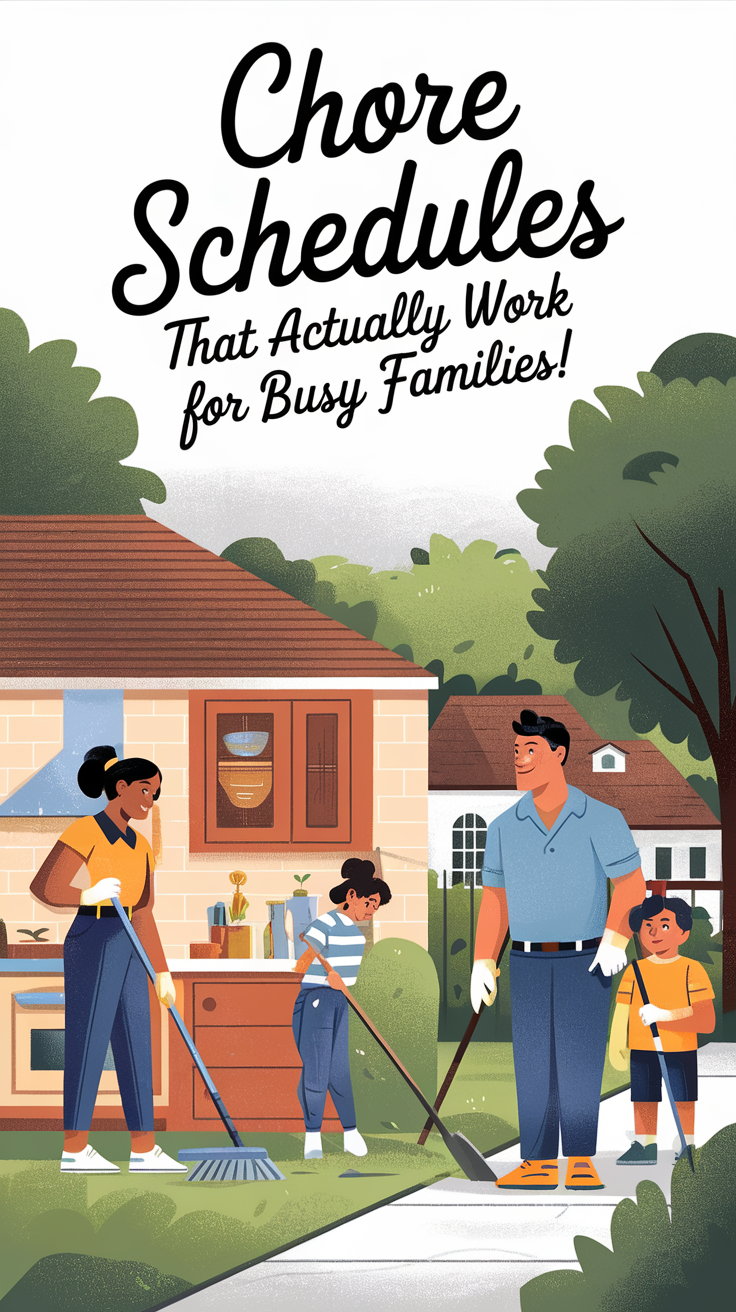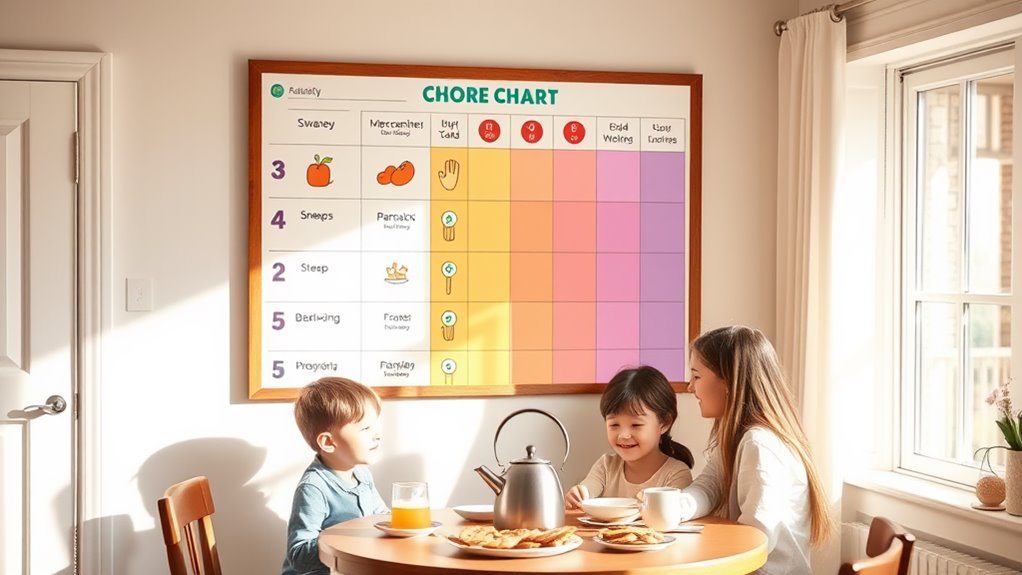Chore Schedules That Actually Work for Busy Families!
Chore schedules that work for busy families can truly save your sanity! Start by creating a colorful chore chart that everyone can see and contribute to—this makes chores feel like a team effort. Assign age-appropriate tasks to keep things manageable; for instance, toddlers can pick up toys while teens can cook simple meals. Flexibility is key, so don’t hesitate to adjust the plan as life happens. Consider adding fun incentives like game nights for completed chores to keep everyone motivated. Stick around, and you’ll discover even more creative ways to make household chores a breeze!
Key Takeaways
- Implement a visual chore chart that engages all family members, fostering ownership and accountability for tasks.
- Create a flexible weekly plan that accommodates everyone’s schedules, preventing conflicts and ensuring chores are manageable.
- Assign age-appropriate tasks to encourage participation, making chores suitable and enjoyable for each family member.
- Regular family check-ins help assess workloads, allowing for adjustments and swaps to maintain harmony and reduce stress.
- Incorporate fun incentives, like game nights or rewards, to motivate family engagement in completing chores together.
Understanding Family Dynamics
Family dynamics can feel like a juggling act, especially when everyone’s schedules are packed. You’ve got different family roles—each member contributes in unique ways, whether it’s the organizer, the peacemaker, or the jokester. Understanding these roles can create a smoother household.
Take a moment to reflect on your family’s communication styles. Are members open and expressive, or do they tend to keep feelings bottled up? Recognizing how your family communicates can help you navigate conflicts and misunderstandings more effectively.
For instance, if one person prefers direct communication while another leans toward a more subtle approach, it’s essential to find common ground.
You might recall a time when a simple misunderstanding led to a blown-up argument over who forgot to take out the trash. If everyone had been clear about their responsibilities and preferred ways of discussing issues, that drama could’ve been avoided.
Benefits of a Chore Schedule
While it might seem like a hassle at first, creating a chore schedule can actually save you a lot of time and stress in the long run.
Think about it—when everyone knows their responsibilities, there’s less chance of tasks slipping through the cracks. You won’t find yourself scrambling last minute to tackle dishes or laundry before guests arrive.
A solid chore schedule also enhances time management for the whole family. By dividing tasks evenly, you guarantee that everyone contributes, making it easier to maintain a clean home without overwhelming any single person.
Plus, it frees up time for activities you all enjoy, like movie nights or weekend outings.
But here’s the real kicker: a chore schedule can foster family bonding. Working together on chores encourages teamwork and communication.
You might even find that those mundane tasks turn into fun moments. I remember my kids giggling while sweeping the floor, turning it into an impromptu dance party!
Types of Effective Chore Systems
When it comes to organizing chores, there are a few systems that really work well for busy families.
You might find that visual chore charts, rotating responsibilities, or daily checklists keep everyone on track and make the whole process a lot smoother.
Let’s explore each of these options so you can find the one that fits your family’s style best!
Visual Chore Charts
Creating a visual chore chart can transform the way your family approaches household tasks. Imagine a colorful chart hanging in your kitchen, featuring fun chart designs that make chores feel like a game. You can use stickers or magnets as visual rewards for completing tasks, turning mundane chores into something your kids actually look forward to.
Start by involving your family in the design process. Let everyone choose their favorite colors and themes; this’ll create a sense of ownership. Break down tasks into manageable sections, so your kids aren’t overwhelmed. For example, you could have categories like “Daily Duties” or “Weekly Wonders.”
Consider using a points system, where kids earn points for each completed task. Once they collect a certain number, they can trade them in for a special treat, like a family movie night or a trip to the park.
The beauty of visual chore charts is their flexibility. You can easily modify them as your family’s needs change.
With a little creativity and consistency, you’ll find that visual chore charts not only streamline household tasks but also foster teamwork and responsibility among family members.
Rotating Responsibilities System
Visual chore charts are a great way to get started, but if you want to keep things fresh and engaging, a rotating responsibilities system might be just what you need. This method not only mixes up the chores but also promotes teamwork through shared responsibilities. Everyone gets a chance to tackle different tasks, making it less monotonous and more fun.
Here’s why you might love this system:
-
Promotes flexibility: When chores rotate, no one feels stuck doing the same thing week after week.
-
Builds skills: Kids learn various responsibilities, from laundry to cooking, equipping them with essential life skills.
-
Encourages teamwork: Working together on different tasks fosters a sense of community and collaboration.
You could set up a simple schedule where roles rotate weekly or even daily, depending on your family’s pace.
Imagine your kids excitedly discussing who’ll take on the dishes or vacuuming next. Not only does this keep chores interesting, but it also teaches them the value of shared responsibilities.
Daily Task Checklists
Having a daily task checklist can make a world of difference for busy families. Imagine waking up, glancing at a clear list of tasks, and feeling that sense of control over your day. You’ll be amazed at how streamlined your daily routines become!
Start by involving the whole family in creating the checklist. This fosters family teamwork and guarantees everyone knows what’s expected. Break down tasks into manageable chunks—things like “make beds,” “empty the dishwasher,” or “feed the pets.” You could even assign specific tasks to different family members to keep things fun and engaging.
Consider using a whiteboard in a common area, where you can all tick off completed tasks. It’s satisfying to see progress, and it adds a bit of friendly competition!
Also, don’t forget to adjust the checklist as needed. Some days will be busier than others, so flexibility is key. For instance, if you have a packed schedule, maybe you prioritize just three essential tasks.
The goal is to create a system that works for your family, making sure you all feel accomplished at the end of the day. So grab that checklist, and let’s get to work!
Creating a Flexible Weekly Plan
Creating a flexible weekly plan starts with taking a good look at your family’s schedule and figuring out when everyone’s available to pitch in.
You’ll want to assign age-appropriate tasks so your kids feel capable and motivated, not overwhelmed.
And don’t forget to sprinkle in some fun incentives—whether it’s a movie night or a special treat, it can make chores a lot more enjoyable for everyone!
Assess Family Schedules
A flexible weekly plan can make all the difference for busy families trying to juggle work, school, and extracurricular activities. By evaluating your family schedules, you can identify potential scheduling conflicts and create a system that works for everyone. Here’s how to get started:
- Gather everyone’s commitments, from school events to work meetings.
- Identify overlapping activities that might cause stress.
- Open a family calendar where everyone can see and contribute.
Start by sitting down with your family and mapping out each person’s schedule. You’ll be surprised at how much you learn about each other’s commitments!
Maybe your daughter has dance practice right when your son has a soccer game. By visualizing it all on a family calendar, you can spot and resolve conflicts before they arise.
Don’t forget to leave some flexibility in your plan. Life happens, and things can change quickly! So, allow for adjustments as needed.
Encourage everyone to communicate openly about their schedules, and before you know it, you’ll have a harmonious plan that keeps your family on track without feeling overwhelmed.
Assign Age-Appropriate Tasks
Once you’ve mapped out your family’s commitments, it’s time to think about how everyone can pitch in around the house. Assigning age-appropriate tasks is essential not just for task delegation but also for skill development. You want to guarantee everyone feels involved without overwhelming them.
Here’s a simple breakdown to help you get started:
| Age Group | Suggested Tasks |
|---|---|
| Toddlers | Put away toys |
| Ages 4-6 | Dusting low furniture |
| Ages 7-10 | Sorting laundry |
| Ages 11-13 | Sweeping and mopping floors |
| Teens 14+ | Cooking simple meals |
Think about what tasks your kids can handle based on their age and abilities. For example, your 7-year-old might love sorting laundry and feel proud seeing their contribution to family life. Not only does this lighten your load, but it also builds their confidence and responsibility. Remember, it’s about balance—choosing tasks that are manageable and fun can foster a sense of teamwork, making chores less of a burden.
Incorporate Fun Incentives
Sometimes, families can feel overwhelmed by the sheer number of chores piling up, but incorporating fun incentives can turn that around. By implementing reward systems, you can motivate everyone to contribute while making chores less of a drag. Here are a few ideas to get you started:
-
Family Game Night: Complete all chores for the week, and enjoy a night of board games or video games together.
-
Choice of Dinner: Let the kid who completes their tasks choose the family dinner for the week.
-
Creative Challenges: Set up friendly competitions where the winner earns a fun outing, like a trip to the local park or ice cream shop.
Integrating these incentives creates a positive atmosphere around chores. You might even find that your kids start tackling their tasks with a bit more enthusiasm!
It’s not just about getting things done; it’s about making the process enjoyable and rewarding. You’ll be surprised how these simple changes can enhance your family’s dynamic while instilling a sense of responsibility.
Assigning Age-Appropriate Tasks
Assigning age-appropriate tasks can transform family chore time from a dreaded obligation into a valuable opportunity for learning and bonding. When you think about task suitability, you’ll find that matching chores to your kids’ ages not only makes the work manageable but also encourages skill development. For example, toddlers can start with simple tasks like putting away toys, while school-age kids can help with sorting laundry or dusting surfaces.
You might remember the first time your child successfully loaded the dishwasher—it’s a small win, but it boosts their confidence and independence. As they grow, you can gradually increase responsibility; maybe your preteen can take over meal prep or even help with grocery shopping. This not only teaches them valuable life skills but also creates a sense of ownership in the home.
Don’t forget to celebrate their efforts! Acknowledge their achievements, no matter how small. This way, chore time becomes less of a chore and more of a family affair, paving the way for teamwork and shared responsibilities.
Tips for Encouraging Participation
Getting kids involved in chores can be a lot easier when you approach it the right way. Here are some effective strategies to boost participation and make chores a family affair:
-
Make it fun: Turn on some music or create a friendly competition to see who can finish their tasks the fastest.
-
Use incentives: Offer a reward system, like extra screen time or a special treat, for completing chores consistently.
-
Encourage teamwork: Pair up kids for tasks to foster teamwork and make it a bonding experience.
By implementing these team motivation strategies, you can transform chores from a dreaded task into an engaging part of family life.
Share the responsibility and emphasize the importance of everyone’s contribution. Use family engagement techniques, like regular check-ins or chore celebrations, to keep the momentum going and encourage accountability.
Adjusting the Schedule as Needed
Life with a busy family can be unpredictable, and that means your chore schedule might need to change from time to time. Whether it’s a last-minute soccer practice or an unexpected family gathering, adapting schedules is essential to keeping harmony at home.
Start by having regular family check-ins. This doesn’t have to be a formal meeting; just gather everyone for a quick chat over dinner. Discuss what’s coming up in the week ahead and make adjustments accordingly. If someone’s overwhelmed with homework, it’s okay to swap chores for that week.
And remember, flexibility is key! If you see that your kids are consistently struggling with a particular chore, don’t hesitate to modify responsibilities. You might find that your youngest is great at sweeping but struggles with dish duty; adjusting based on their strengths can make chores feel less like a burden.
Ultimately, effective family communication is what keeps your chore schedule running smoothly. When everyone feels heard and valued, it fosters teamwork and helps avoid unnecessary stress.
Embrace the chaos, adapt as needed, and watch your family thrive!
Frequently Asked Questions
How Do We Handle Chores During Busy Holiday Seasons?
During busy holiday seasons, you can tackle chores by implementing holiday chore strategies that promote festive family teamwork. Divide tasks, set timers, and make it fun. You’ll create lasting memories while keeping things organized!
What if One Child Consistently Refuses to Do Their Chores?
If one child consistently refuses chores, it might be a motivation issue. Try sibling accountability; they could inspire each other. Share stories of teamwork in your family, and watch their willingness to contribute grow!
Can We Include Pets in the Chore Schedule?
Absolutely, you can include pets in the chore schedule! Assign pet responsibilities like feeding or walking, and consider chore rewards for completing them. This can teach responsibility and make it fun for everyone involved.
How Do We Manage Chores When Parents Work Different Shifts?
You know, it’s like juggling flaming swords when parents work different shifts. Embrace shift flexibility and create a chore rotation that fits everyone’s schedule. It’ll lighten the load and keep your household running smoothly!
What Tools or Apps Can Help Manage Family Chore Schedules?
To manage chore schedules effectively, you can use apps like Todoist or Cozi. They offer chore tracking features and promote family collaboration, making it easier for everyone to stay on the same page with responsibilities.



